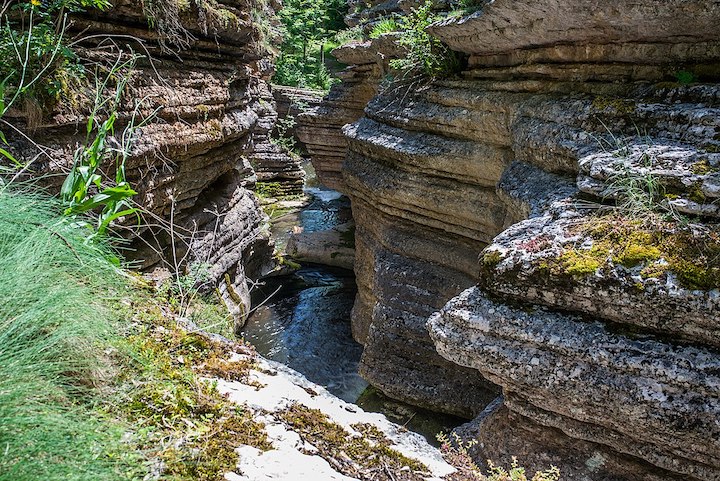The village "Slavinja" in the east of Serbia has only a few dozen denizens and seems, at a glance, to be just one of many colorful mountainside villages. It is nestled on the slopes of "Stara" Mountain, about 30km away from Pirot.
Still, nature has a way of hiding its beauty far away and then surprising us when we learn about it by chance. That's how this little village hides away the Rosomace canyon, that's millions of years old and makes for an enchanting sight.
 Photo: Wikipedia / Marko.vl
Photo: Wikipedia / Marko.vl
Canyon within the Jurassic era stone
On the way from Stara mountain to the Visocica river down south, Rosomaca had begun to cut into the layers of limestone rock. Though not too large, it first broke through the cave. The came ceiling had begun to give under the effect of time and natural forces, while the river filed down and bore into the surrounding rocks. The spots where it poured down into the riverbed became the Rosomacki canyon.
Sheer cliffs, thanks to the river flow, have developed indentations near the bottom in the shape of the whirlpools. Their shape resembles cauldrons, so the canyon got the folk name Rosomacki cauldrons. It's also called Rosomacko grotto or Slavinjski cauldrons due to the proximity of the village of the same name.
The canyon itself with its almost 800m of altitude stretches all the way to the neighboring village Rosomac. Though unique for its geological and geomorphological characteristics, the 'pots of Rosomac' are proof that nature can create miracles in miniature as well. The canyon itself is no wider nor longer than 5m. The height of the sheer cliffs is no greater than 70m and the girth of its 'cauldrons' can go up to 4m in diameter.
In the riverbed itself, the forces of nature have arranged a series of waterfalls and slopes with very interesting formations. The rocks intersected by Rosomaca reveal straight horizontal stripes throughout the canyon. These millions of years old deposits date back all the way to the Jurassic era.
 Photo: Wikipedia - Marko.vl
Photo: Wikipedia - Marko.vl
This is why they still contain fossil remains of organisms that inhabited the deepest sea levels of that era. Getting to the cauldrons within Rosomaca's riverbed is almost impossible due to the sheer cliffs surrounding them and even during the hottest summer days the temperature of the water never goes over 5-6 degrees Celsius.
Still, it's not difficult to reach the canyon itself. The Rosomaca river flow leads straight up to it from the Slavinje village and you can reach the top by climbing the rocks covered in grass and low-growing vegetation. The climb itself isn't too difficult and the view of the clear water - especially from the left side of the canyon - is worth every step.
For anyone who would like to capture this beauty in photo shoots, our advice is to organize their visit during the summer months. The visitors can get accommodations in the nearby village Visocka Rzana and stay in authentic old stone houses. Another location worth touring is the four-century old church dedicated to St. George in Slavinja, while the nearby Park of nature "Stara Mountain" has an abundance of beautiful, clear waterfalls.
One of the most famous ones is the 15m tall Tupavica. Translucent water slops down the red-rock 'stairs'. This waterfall is located near the village Dojkinci at an 1050m altitude. It does happen sometimes during summer that Tupavica dries out, so if you're looking to visit this site, it's best to do so during the spring and autumn months.
*Cover photo: Wikipedia / Nikola Veljković





 VILLA BOROVA AND AGENCIES MIROS
VILLA BOROVA AND AGENCIES MIROS





